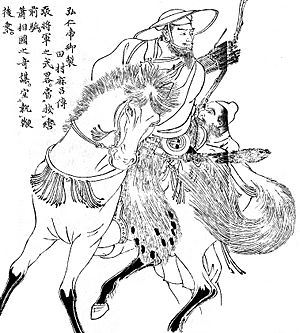Sakanoue no Tamuramaro facts for kids

Sakanoue no Tamuramaro (坂上 田村麻呂, 758 – June 17, 811) was a very important person in early Japanese history. He was a noble at the emperor's court and a powerful general. He even held the title of shōgun, which means "commander-in-chief."
Tamuramaro lived during the Heian period in Japan. He served three different emperors: Emperor Kanmu, Emperor Heizei, and Emperor Saga. He was known for his military skills and his role in expanding Japan's territory.
Military Achievements
Sakanoue no Tamuramaro was a key figure under Emperor Kanmu. The emperor gave him the big job of leading armies to conquer the Emishi. The Emishi were a group of people living in the northern part of Honshū, Japan's main island.
Tamuramaro was very successful in his campaigns. He helped the Japanese Empire expand its control further north. Some Emishi people moved to Hokkaidō because of these campaigns. However, many Emishi stayed in the Tōhoku region and became part of the growing Japanese Empire.
Tamuramaro was the second person in history to receive the special title of Sei-i Taishōgun. This title means "Great General who Subdues the Barbarians." The first person to get this title was Ōtomo no Otomaro.
Nebuta Festivals
The famous Tanabata festivals in Aomori Prefecture are linked to Sakanoue no Tamuramaro. These festivals, like the Nebuta festival in Aomori City and Neputa Festival in Hirosaki City, attract millions of visitors.
These festivals feature huge, colorful paper floats that light up. They are painted with mythical figures. Teams of people carry these giant lanterns through the streets. People believe these lanterns remember Tamuramaro's clever battle strategy.
Legend says Tamuramaro ordered large, bright lanterns to be placed on hilltops. When the curious Emishi came to investigate these lights, they were captured. This story shows how Tamuramaro was seen as a smart and innovative leader. For a long time, the prize for the best festival float was even called the Tamuramaro Prize.
It's important to know that historical records don't show Tamuramaro going further north than Iwate Prefecture.
Later Life and Legacy
Sakanoue no Tamuramaro was also involved in building projects. His name is connected to payments for the construction of Kiyomizu Temple in the late 700s. This temple is a very famous and beautiful site in Japan.
Tamuramaro passed away in 811 when he was 54 years old. Emperor Saga was very sad to lose him. The emperor honored Tamuramaro by giving out large amounts of silk, cotton, and rice. He also ordered Tamuramaro's bow, arrows, quiver, and sword to be placed in his coffin.
His tomb is located in Kyoto, Japan. It's important not to confuse his tomb with Shōgun-zuka. Shōgun-zuka is a ceremonial statue placed by Emperor Kanmu when he moved the capital to Kyoto.
See also
 In Spanish: Sakanoue no Tamuramaro para niños
In Spanish: Sakanoue no Tamuramaro para niños
- List of shōguns
- Tamura clan

